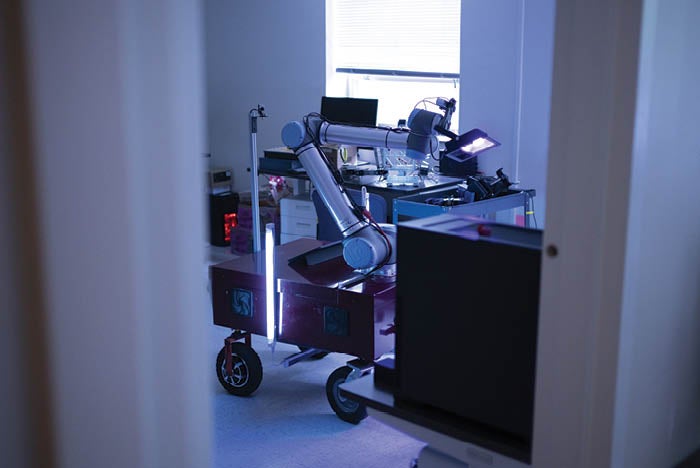University tests out mobile UVC robot

The DINGO’s mobility functions were tested at a COVID-19 clinic.
Image courtesy of the University of Virginia
A robot originally created to be used in response to earthquakes and fires has been rethought, revamped and recreated to help fight another larger scale calamity: the COVID-19 pandemic.
Created by mechanical engineer Tomonari Furukawa and researcher Dean Conte, both of the University of Virginia in Charlottesville, the robot, DINGO, uses ultraviolet (UVC) light to disinfect surfaces. “Since we had recently demonstrated that our robot can complete a large number of tasks in a disaster scenario, we knew we could use our state-of-the-art technology right away for robotic decontamination,” Furukawa says.
The importance of a thoroughly clean health care environment was driven home even more emphatically by the pandemic. The inventors of DINGO wanted to design a tool that would allow these spaces to be disinfected while limiting exposure of physicians, staff and patients to germs and the dangers associated with them.
However, the robot still requires human interaction. First, a handler moves DINGO around so that its cameras can scan the space and turn those images into a 3D map. Then, a human operator working remotely uses that map to instruct the robot. It moves to the selected spot on its own, emitting light from its sides and bottom to clean walls and floors. Meanwhile, its highly mobile neck twists and turns to illuminate and decontaminate other surfaces and items, like desks, chairs and other equipment in the room.
The robot’s mobility has been tested at a COVID-19 clinic in Richmond, Va. The researchers say this type of mobility could offer hospitals a new option along with the pedestal-type robots commonly used in facilities today. Pedestal robots are typically based in the middle of an enclosed room and use high amounts of UVC light to reach all corners of the room. The inventors of the DINGO project say that because the robot can get much closer to surfaces because of its mobility, it should require a less powerful light. However, they say, there is still more work to be done to turn this concept into a health care mainstay.
“Semi-autonomous robots capable of completing real-world missions will come into increasing usage over time in a range of settings,” Furukawa says. “They are very good at accomplishing specific tasks in specific environments and are well-suited for use in dangerous locations.”


